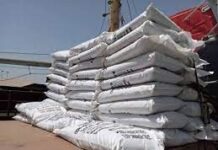 management, live stock waste from enteric fermentation in cattle, manure management, fossil fuel consumption from transportation and processing, and others. Each of these sources is discussed below along with possible ways of reducing emissions. The percentage of GHG emissions from each agricultural practice in The Gambia is sourced from The Gambia Second National Communications to the UNFCCC document which was published by the UNFCCC in 2012.
Agricultural Soil Management
Nitrous oxide emissions from agricultural soils and bush and crop residue burning account for 10 percent of the total emissions from the agricultural sector. In a developed world like the United States of America, this accounts for about 60 percent of the total emissions from the agricultural sector (USEPA 1990 – 2005). Nitrous oxide is produced naturally in soils through the microbial processes of nitrification and de-nitrification. This simply means the decomposition of soil organic matter. In between the nitrification and de-nitrification processes, nitrous oxide is produced.
The large increase in the use of nitrogen fertilizer ( ex. compound fertilizer or urea) for the production of a high nitrogen-consuming crop like corn has increased the emissions of nitrous oxide worldwide. Although nitrogen fertilizer is essential for increasing crop production, the development of practices for more efficiently using nitrogen fertilizer has the potential to significantly reduce nitrous oxide emissions while also reducing production costs and mitigating the nitrogen contamination of surface and ground waters. This means that if you apply nitrogen fertilizer to your crops, DO NOT broadcast it. Broadcasting means applying the fertilizer by throwing it everywhere in the crop field. Instead, use band application. Band application is when you place the fertilizer at least six inches from the stems of crops in a row and bury it in the soil. In this way the crop will efficiently use the fertilizer and less of that fertilizer will emit nitrous oxide in the atmosphere. You will also not waste the amount of your fertilizer as opposed to when you broadcast it.
Enteric Fermentation
Methane is produced as part of the normal digestive processes in animals, mostly cattle. During digestion, microbes in the animal’s digestive system ferment feed. This process, called enteric fermentation, produces methane as a by-product which can be emitted by the exhaling and belching of the animal. Because of their unique digestive system, ruminant animals (e.g. cattle) are the major emitters of methane. Beef cattle account for about 70 percent and dairy cattle for about 25 percent of these methane emissions in the US. It is worth noting that in the US, cattle rearing is entirely done in a confined environment where there is less movement of the cattle. Because of that management system, these cattle give off more methane than expected. However, in The Gambia, the combination of animal husbandry, rice cultivation, and bush and crop residue burning account for 51 percent of total emissions. The cattle rearing system in The Gambia is characterized by a free range system where the cattle freely move about and travel long distances each day grazing on natural vegetation. In this type of management system, less methane gas is given off. Therefore, if beef and dairy cattle numbers increase in a confined environment, methane emissions will also increase. Feed qualify and feed intake influence the level of methane emissions. In general, higher feed quality and higher feed intake lead to higher methane emissions.
Manure Management
Methane is produced by the anaerobic (without oxygen) decomposition of manure. When manure is handled as a solid or deposited naturally on grassland, it decomposes aerobically (with oxygen) and creates little methane emissions. However, manure stored as a liquid or slurry in lagoons, ponds, tanks or pits, as is common in the US, decomposes anaerobically and creates methane emissions. Dairy cattle and pigs produce about 85 percent of the methane emissions in the US. In The Gambia, this percentage is 64. This is because The Gambia has a free range small ruminant and pig management system and their diets are generally of low quality and less in quantity. Methane emissions will increase as the number of large scale livestock confinement systems increases. Methane emissions can be reduced through the application of technologies designed to capture the methane and use it as an energy source. In addition to reducing methane emissions, methane capture will improve the profitability of the livestock operation by offsetting the need for fossil fuel energy from outside sources.
Carbon Dioxide from Fossil Fuel Consumption
The use of fossil fuels (i.e. diesel or petrol) in agricultural production (ex. by operating tractors on the farm and or using vehicles to transport farm inputs and produce) accounts for eight percent of the emissions from agriculture in the US. The Gambia, however, does not have any percentage emissions for fossil fuel use may be because our farmers seldom use tractors for their field operations. Even the very few who use tractors on their farms, their usage is very limited and it is on seasonal basis only. Using renewable fuels (like using solar-power tractors) can reduce the carbon dioxide emissions from agriculture production.
Other
A variety of other sources produce greenhouse gas emissions. For example, most of the world’s rice and all of U.S. rice are grown on flooded fields which prevent atmospheric oxygen from entering soil. When rice is grown with no oxygen, the soil organic matter decomposes under anaerobic conditions and produces methane that escapes into the atmosphere and causes emissions. In The Gambia, methane emission under rice production is estimated at 33 percent. In order to reduce emissions from rice cultivation, the rice field should be drained of water at some time of the growth of the crop to minimize anaerobic fermentation.
Sidat Yaffa, Ph.D.
Contact: [email protected]
]]>
management, live stock waste from enteric fermentation in cattle, manure management, fossil fuel consumption from transportation and processing, and others. Each of these sources is discussed below along with possible ways of reducing emissions. The percentage of GHG emissions from each agricultural practice in The Gambia is sourced from The Gambia Second National Communications to the UNFCCC document which was published by the UNFCCC in 2012.
Agricultural Soil Management
Nitrous oxide emissions from agricultural soils and bush and crop residue burning account for 10 percent of the total emissions from the agricultural sector. In a developed world like the United States of America, this accounts for about 60 percent of the total emissions from the agricultural sector (USEPA 1990 – 2005). Nitrous oxide is produced naturally in soils through the microbial processes of nitrification and de-nitrification. This simply means the decomposition of soil organic matter. In between the nitrification and de-nitrification processes, nitrous oxide is produced.
The large increase in the use of nitrogen fertilizer ( ex. compound fertilizer or urea) for the production of a high nitrogen-consuming crop like corn has increased the emissions of nitrous oxide worldwide. Although nitrogen fertilizer is essential for increasing crop production, the development of practices for more efficiently using nitrogen fertilizer has the potential to significantly reduce nitrous oxide emissions while also reducing production costs and mitigating the nitrogen contamination of surface and ground waters. This means that if you apply nitrogen fertilizer to your crops, DO NOT broadcast it. Broadcasting means applying the fertilizer by throwing it everywhere in the crop field. Instead, use band application. Band application is when you place the fertilizer at least six inches from the stems of crops in a row and bury it in the soil. In this way the crop will efficiently use the fertilizer and less of that fertilizer will emit nitrous oxide in the atmosphere. You will also not waste the amount of your fertilizer as opposed to when you broadcast it.
Enteric Fermentation
Methane is produced as part of the normal digestive processes in animals, mostly cattle. During digestion, microbes in the animal’s digestive system ferment feed. This process, called enteric fermentation, produces methane as a by-product which can be emitted by the exhaling and belching of the animal. Because of their unique digestive system, ruminant animals (e.g. cattle) are the major emitters of methane. Beef cattle account for about 70 percent and dairy cattle for about 25 percent of these methane emissions in the US. It is worth noting that in the US, cattle rearing is entirely done in a confined environment where there is less movement of the cattle. Because of that management system, these cattle give off more methane than expected. However, in The Gambia, the combination of animal husbandry, rice cultivation, and bush and crop residue burning account for 51 percent of total emissions. The cattle rearing system in The Gambia is characterized by a free range system where the cattle freely move about and travel long distances each day grazing on natural vegetation. In this type of management system, less methane gas is given off. Therefore, if beef and dairy cattle numbers increase in a confined environment, methane emissions will also increase. Feed qualify and feed intake influence the level of methane emissions. In general, higher feed quality and higher feed intake lead to higher methane emissions.
Manure Management
Methane is produced by the anaerobic (without oxygen) decomposition of manure. When manure is handled as a solid or deposited naturally on grassland, it decomposes aerobically (with oxygen) and creates little methane emissions. However, manure stored as a liquid or slurry in lagoons, ponds, tanks or pits, as is common in the US, decomposes anaerobically and creates methane emissions. Dairy cattle and pigs produce about 85 percent of the methane emissions in the US. In The Gambia, this percentage is 64. This is because The Gambia has a free range small ruminant and pig management system and their diets are generally of low quality and less in quantity. Methane emissions will increase as the number of large scale livestock confinement systems increases. Methane emissions can be reduced through the application of technologies designed to capture the methane and use it as an energy source. In addition to reducing methane emissions, methane capture will improve the profitability of the livestock operation by offsetting the need for fossil fuel energy from outside sources.
Carbon Dioxide from Fossil Fuel Consumption
The use of fossil fuels (i.e. diesel or petrol) in agricultural production (ex. by operating tractors on the farm and or using vehicles to transport farm inputs and produce) accounts for eight percent of the emissions from agriculture in the US. The Gambia, however, does not have any percentage emissions for fossil fuel use may be because our farmers seldom use tractors for their field operations. Even the very few who use tractors on their farms, their usage is very limited and it is on seasonal basis only. Using renewable fuels (like using solar-power tractors) can reduce the carbon dioxide emissions from agriculture production.
Other
A variety of other sources produce greenhouse gas emissions. For example, most of the world’s rice and all of U.S. rice are grown on flooded fields which prevent atmospheric oxygen from entering soil. When rice is grown with no oxygen, the soil organic matter decomposes under anaerobic conditions and produces methane that escapes into the atmosphere and causes emissions. In The Gambia, methane emission under rice production is estimated at 33 percent. In order to reduce emissions from rice cultivation, the rice field should be drained of water at some time of the growth of the crop to minimize anaerobic fermentation.
Sidat Yaffa, Ph.D.
Contact: [email protected]
]]>




















